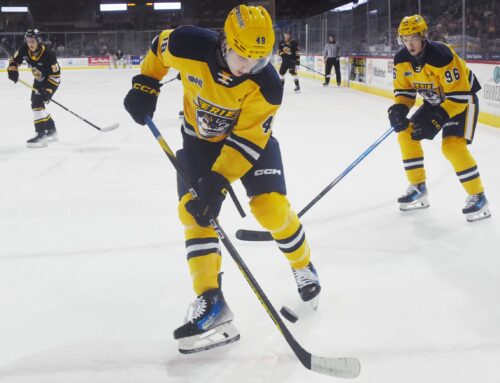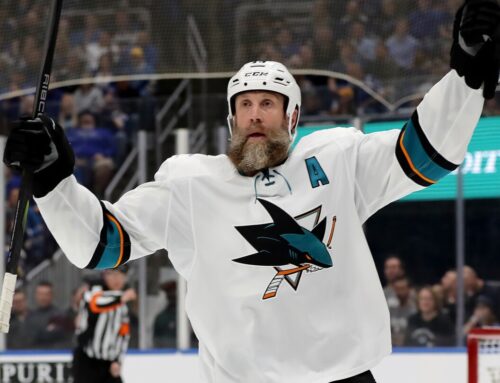
We had an intense Winter Classic on Wednesday afternoon as Nashville went to Dallas to play the Stars at the Cotton Bowl. The home team managed a 4-2 win, and the game didn’t take long to get heated.
Corey Perry elbowed Predators defenceman Ryan Ellis in the head just a few minutes into the game and was issued a five-minute major with an ejection. Ellis left the game and did not return.
Nashville scored a pair of power-play goals on Perry’s major (and a 5-on-3) to take a lead that would hold until the third period. Dallas scored a pair of power-play goals of their own early in the third to take the lead, with Andrej Sekera adding an insurance marker.
Matt Duchene had a goal and an assist, giving him seven points in his last six games.
*
Columbus placed forward Alex Texier on the injured reserve with a lumbar stress fracture. He is out indefinitely.
It’s the new year but on such a slow day for NHL games and practice there’s not really a lot to talk about. On days such as these, I get pretty much free reign to talk about what I feel like – you poor devils – so this time, I want to look back for a minute. More precisely, I want to look back on prior assumptions and see what’s changed.
One area where fantasy players are blind is, obviously, their biases. Whether conscious or not, we all have internalized biases that affect the way we perceive, absorb, and analyze fantasy hockey. Sometimes we can alter these biases, sometimes we can't. What we can do is look back on what we thought we knew at a given point, and what’s changed since. It's worse to operate with incorrect information than no information because the former guarantees incorrect results while the latter still leaves room for someone to get lucky. So let’s talk about some situations where a change of opinion may be warranted, for myself and others.
The whole Kevin Shattenkirk ordeal is something that has honestly gotten me to think about hockey more than just about anything else in years. Here’s the long and short of it: how does a player go from looking so bad that he has to be bought out by a bottom-feeding team that is still playing terrible defencemen every night, to looks like a top-pair defenceman (as he’s often been) for a Cup contender? Listen, I know that bad teams can make good players looks bad, believe me, I’m a Habs fan. But Shattenkirk looked like he was a year away from being out of the NHL and now we’re wondering how many years his extension will be after this season. It’s a huge turnaround, and it can’t solely be pinned on the Rangers being awful, can it?
What if it can? My running theory that some teams and some coaches are so bad that the vast majority of players cannot overcome their ineptitude. That doesn’t include generational players like McDavid or Crosby, but just about everyone else. What if a player is just in such a bad situation that they can’t possibly overcome the environment?
It’s something I’ve thought about a lot about the last decade of Oilers hockey (just look at the goalies that have left and succeeded, not to mention Taylor Hall’s MVP and Jeff Petry’s elite play). How many players were stuck on those awful teams with awful coaches and were eventually ran out of the NHL? How many players over the years have had their NHL dreams cut short because coaching and management never provided them the tools necessary to succeed?
I’m honest when I repeat that Shattenkirk’s turnaround has kind of altered my view of hockey. I’m a lot more forgiving for players struggling on bad teams with bad coaches now. There’s only so much that Dylan Larkin can do.
I guess everyone starts fading away eventually, but I really thought Burns would be an elite fantasy option for a few more years; there was a reason I had him ranked inside my top-5 this season. I know that the Sharks lost some talent, especially in Joe Pavelski, but that this team has gone from Cup contender to potential lottery team mirrors the decline in Burns’ game.
The thing is, it’s not really that bad of a season for most any fantasy hockey defenceman. At the least, he’s on pace for over 10 goals, over 50 points, over 200 shots, over 100 blocks, and over 20 PPPs. That’s something that very few defencemen will produce every year, but that’s certainly a downturn for Burns.
What’s curious about all this is that I’m not sure how much is related to Burns. What I mean is that the team had generated at least 61 shot attempts per 60 minutes at 5-on-5 every season he was in San Jose until this year, and his last three years were 66-68-68. This year that’s plummeted to 52.5. Surely the loss of Pavelski doesn’t explain the team dropping like 25 percent in their shot rate, so what else is going on?
It’s likely just a confluence of a bunch of guys being in their decline, plus the loss of Pavelski, that is the issue here. It really does seem like none of their defencemen can pass anymore, but it’s naturally more involved than that. What I do know is that until this team gets some influx of talent, there’s about six good players on this roster and most of them are over 30 years old. It seems the future for Burns is more 50-point seasons rather than 70-point seasons.
Nathan MacKinnon/Mikko Rantanen
Maybe this one is more my own personal bias than it is for others, but I was really concerned about the apparent co-dependence between Nathan MacKinnon and Mikko Rantanen. As someone who was a MacKinnon owner in a keeper league, I was nervous that one player needed the other to succeed. Sort of like how Draisaitl and McDavid need each other (even if McDavid is much less dependent than Drai). Well, as we saw in that MacKinnon performance when both Rantanen and Gabriel Landeskog were out of the lineup, it certainly isn’t a co-dependence situation. At the very least, we now know that MacKinnon can do the heavy lifting no matter the surrounding talent, which is a nice cushion to have.
Ottawa
I don’t think I’m the only one who thought that the Senators were literally five years away from contending. I know that teams have been able to turn things around pretty quickly (the Leafs did it in a couple years) but one thing Ottawa lacked was a horde of proven young talent. Especially coming into the 2019-20 season, it seemed this team had Brady Tkachuk, Thomas Chabot, and that was it.
On the contrary, it looks like there are a lot of good pieces on this team. At the least, Nick Paul looks like a two-way third-line winger; someone who can play good defence and chip in 10-15 goals a year (that’s valuable). Anders Nilsson looks like he’s at least a starter capable of bridging the team until they get to their future franchise goalie. Erik Brannstrom does not look overwhelmed at the NHL level, and they really need him to come through. There’s also Anthony Duclair, who is finally the goal scorer we all hoped he could be.
More than anything, it seems like DJ Smith is a great coach, and that’s important for a team in transition. I mean, it’s important for any team, but a guy who can coach young players and work with a lot of moving parts all year is crucial for this particular franchise, and Smith is passing this test in spades.
I still think there’s a long way to go before Ottawa has the pieces needed for a deep playoff run, but at least we’re talking maybe 2-3 years rather than 5-6. Now they just need a new owner who will actually spend to the cap on this team.
High-scoring NHL
When there’s a change in environment, people want to know if the change is for real or not. Usually, at least early on, the answer is, “maybe”. As with home run spikes and dips in baseball, and change in shot selection in basketball, there’s no parsing whether what’s happening now will keep happening in the future. We like to see a sample size larger than n=1, or even n=2, and that appears to be what we’re having this year.
Last year, there were more goals per game in the NHL than any year since 2005-06. This year, there have been more goals per game in the NHL than any year since last year. A higher-scoring NHL with more power-play opportunities should change how we evaluate players. It should change from how we value certain categories to just how much we should value an event in each category (how much is a goal actually worth). I went over stuff like this last summer and will do so again this summer as we will then have a three-year sample of increased scoring.
If I could just say that I think there’s another step the NHL can take here. For whatever reason, they’re completely fine with obstruction interference now. I don’t know why. That could lead to more PP opportunities and more goals.





 UTA
UTA MTL
MTL BUF
BUF MIN
MIN FLA
FLA VAN
VAN
 WSH
WSH
